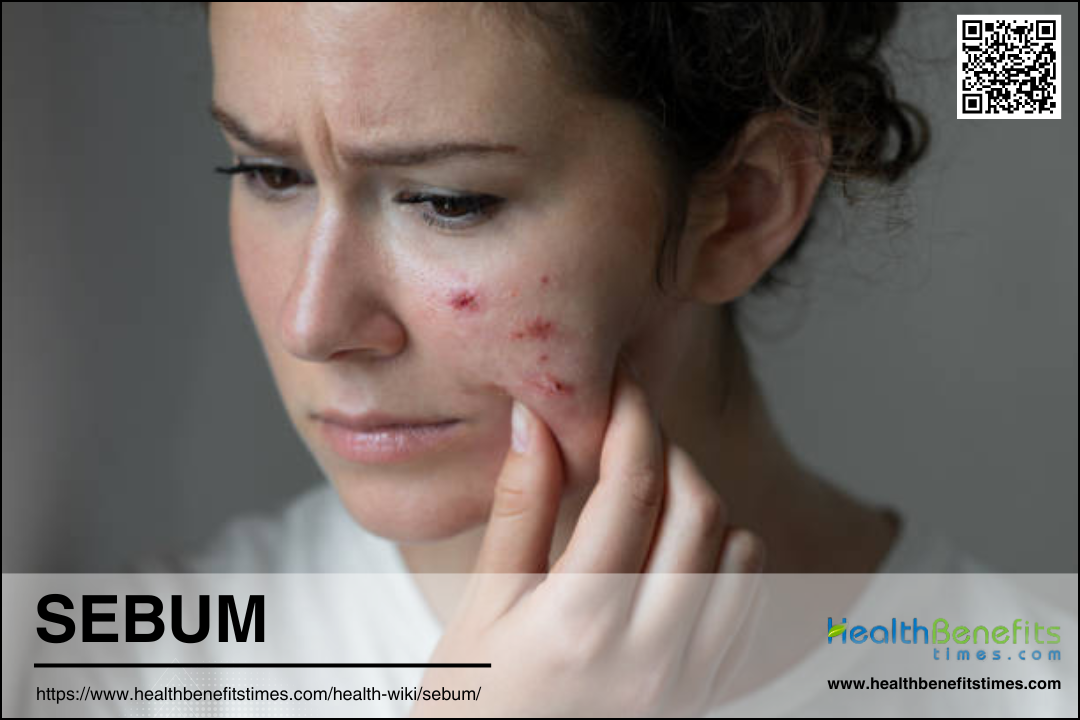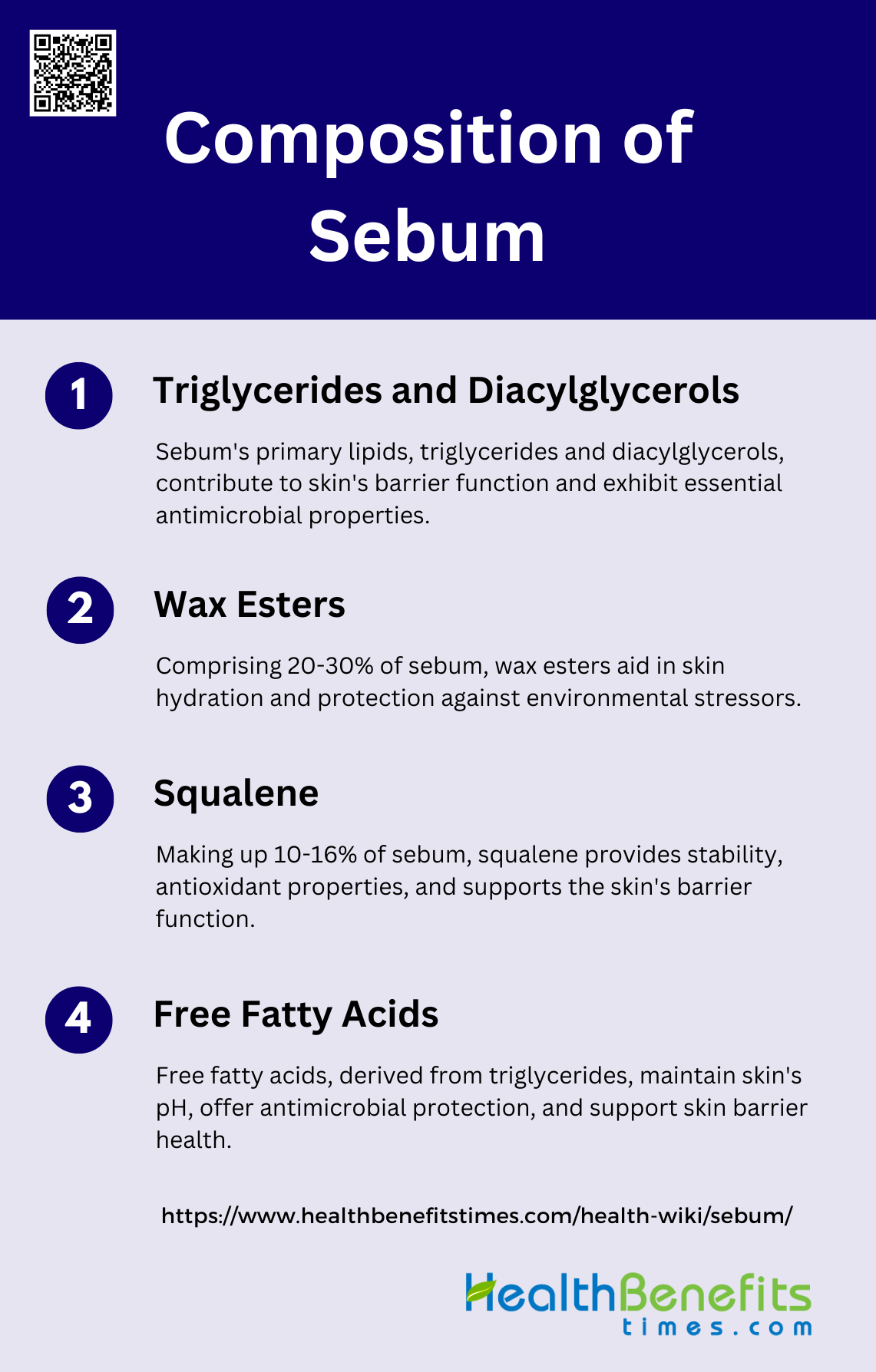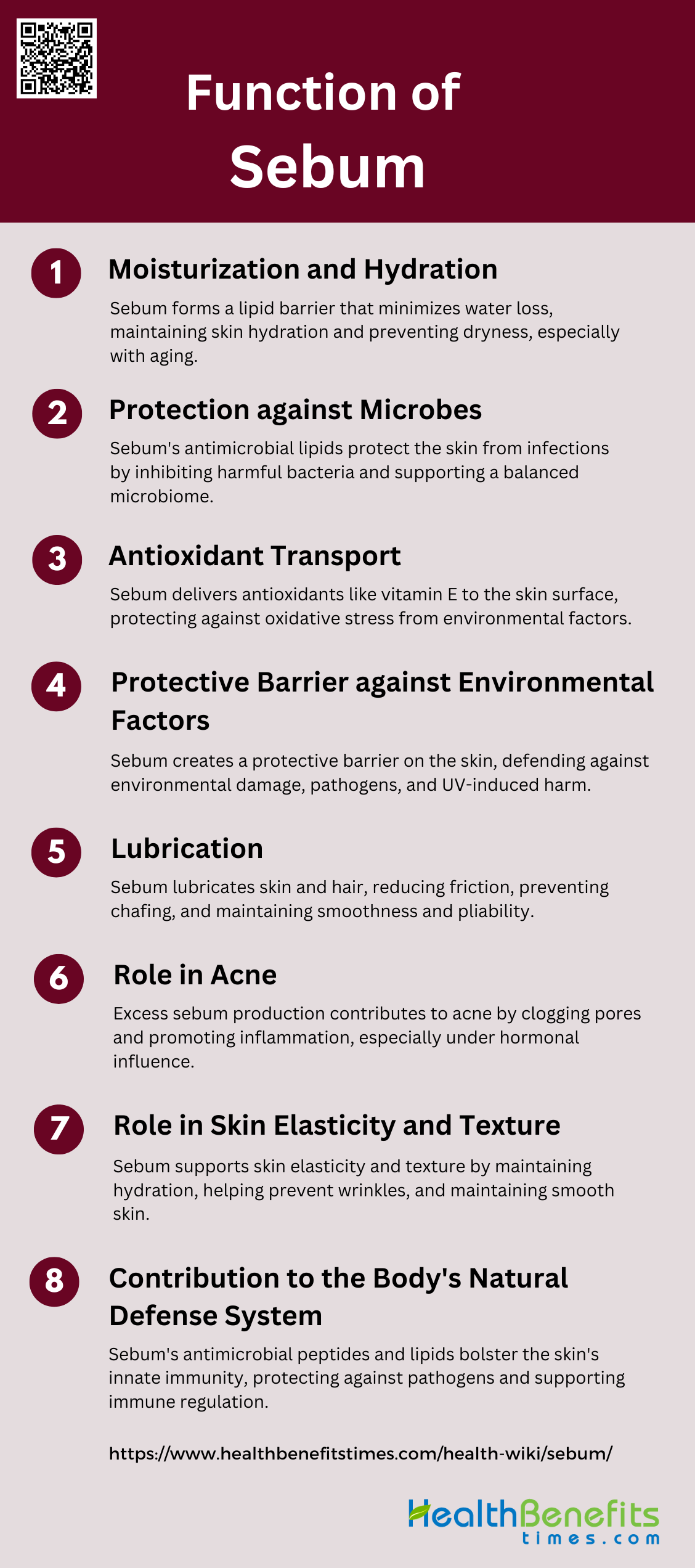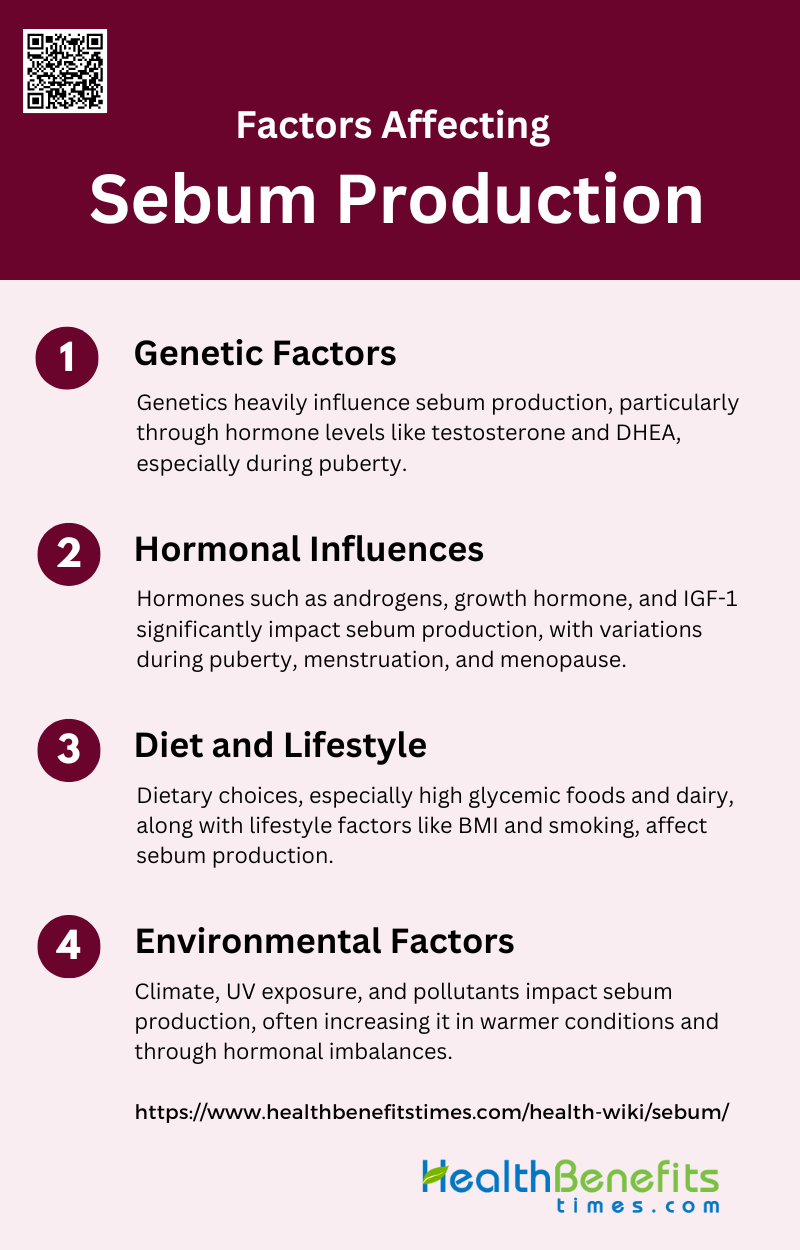Sebum is an oily substance produced by the sebaceous glands in the skin. It plays a crucial role in maintaining skin health by providing a natural barrier that helps to keep the skin moisturized and protected from external elements. Sebum is composed of a mixture of lipids, including triglycerides, wax esters, squalene, and free fatty acids. While essential for skin hydration, excessive sebum production can lead to oily skin and contribute to the development of acne, as it can clog pores and create an environment conducive to bacterial growth. Factors such as hormonal changes, diet, and genetics can influence sebum production, making it a key focus in dermatological treatments aimed at managing conditions like acne and enlarged pores.
Composition of Sebum
Sebum is a complex mixture of lipids produced by the sebaceous glands in the skin. It plays a crucial role in maintaining skin health by providing a protective barrier, preventing water loss, and exhibiting antimicrobial properties. The primary components of sebum include:
1. Triglycerides and Diacylglycerols
Triglycerides (TG) and diacylglycerols (DAG) are significant components of sebum, accounting for a substantial portion of its lipid content. Triglycerides are primarily hydrolyzed by bacteria in the anaerobic environment of the sebaceous gland, resulting in the production of free fatty acids by the time sebum reaches the skin surface. The comprehensive analysis of sebum lipids has identified 95 families of triacylglycerols and 29 families of diacylglycerols, highlighting their diversity and abundance. The presence of these lipids is crucial for maintaining the skin’s barrier function and providing antimicrobial properties, which are essential for skin health.
2. Wax Esters
Wax esters (WE) are another major component of sebum, constituting about 20-30% of its composition. These esters are formed by the esterification of fatty acids with long-chain alcohols, resulting in a unique lipid structure that contributes to the skin’s protective barrier. In humans, wax esters are the second most abundant lipid in sebum, following triglycerides. The analysis of sebum has identified 28 species of wax esters containing the 16:1 fatty acyl moiety, indicating their structural diversity. Wax esters play a critical role in maintaining skin hydration and protecting against environmental stressors.
3. Squalene
Squalene is a unique and highly abundant component of sebum, making up about 10-16% of its lipid content. Unlike other sebum lipids, squalene is a standalone, unsaponifiable lipid, meaning it does not form soap when mixed with alkali. This lipid is notable for its stability and resistance to oxidation, which helps protect the skin from oxidative damage. Squalene’s presence in sebum is relatively constant, even under conditions of severe caloric restriction, where other lipid components may decrease. Its role in sebum is multifaceted, contributing to the skin’s barrier function and providing antioxidant properties.
4. Free Fatty Acids
Free fatty acids (FFA) are a significant component of sebum, resulting from the hydrolysis of triglycerides by bacterial lipases. They account for about 16.5% of the lipid content in sebum. These fatty acids are crucial for maintaining the skin’s pH and providing antimicrobial properties, which help protect against pathogenic bacteria. The comprehensive analysis of sebum has identified more than 48 different free fatty acids, highlighting their diversity. The presence of free fatty acids in sebum is essential for skin health, as they contribute to the skin’s barrier function and have antimicrobial activity against gram-positive bacteria.
Where is Sebum Produced?
Sebum is produced by the sebaceous glands, which are small oil-producing glands located in the skin. These glands are typically associated with hair follicles and are responsible for the holocrine secretion of sebum, a complex mixture of lipids, cell debris, and other substances. Sebum plays a crucial role in maintaining skin homeostasis by providing lubrication and protection to the skin and hair. The production of sebum is influenced by various factors, including hormonal changes, particularly androgens, which can increase sebum production and contribute to conditions such as acne vulgaris. Additionally, sebum has antimicrobial properties and helps in the transport of antioxidants to the skin surface, contributing to the skin’s innate immunity and overall health.
Sebaceous glands are skin appendages that are distributed across the entire surface of the skin, except for the palms of the hands and soles of the feet. The areas of the body with the highest concentration of sebaceous glands include the face, scalp, chest, and back. These glands are particularly abundant on the face and scalp, where they can number up to 400-900 glands per square centimeter, making these regions the most populous and productive in terms of sebaceous gland activity. Additionally, the midline of the back and the perineum also have a high density of sebaceous glands. The head and neck region, including the oral mucous membranes and parotid glands, also bear a significant number of sebaceous gland ectopias.
Function of Sebum
Sebum, produced by the sebaceous glands, serves multiple essential functions for the skin. It helps to maintain skin hydration, provides a protective barrier against environmental damage, and possesses antimicrobial properties. The key functions of sebum include
1. Moisturization and Hydration
Sebum plays a crucial role in maintaining skin hydration by forming a lipid barrier that minimizes transepidermal water loss (TEWL). This barrier helps retain moisture within the skin, ensuring it remains supple and hydrated. Studies have shown that sebum production decreases with age, leading to lower skin surface lipid levels and reduced hydration, particularly in older adults. Additionally, moisturizers that support sebum function can enhance skin barrier integrity and hydration, as evidenced by clinical trials showing improved skin moisture content with the use of specific moisturizers. Thus, sebum is essential for maintaining optimal skin hydration and preventing dryness.
2. Protection against Microbes
Sebum has significant antimicrobial properties that protect the skin from microbial infections. It contains free fatty acids (FFAs) like lauric acid, palmitic acid, and oleic acid, which exhibit antibacterial activity against a range of gram-positive bacteria, including Propionibacterium acnes. These FFAs enhance the expression of antimicrobial peptides such as human beta-defensin-2 (hBD-2) in sebocytes, bolstering the skin’s innate immune defense. Moreover, sebum’s lipid composition can influence the skin microbiome, providing nutrients for beneficial microbes while inhibiting pathogenic ones. This dual role underscores sebum’s importance in maintaining a balanced and protective skin microbiome.
3. Antioxidant Transport
Sebum serves as a vehicle for transporting antioxidants to the skin surface, where they can neutralize harmful free radicals. These antioxidants, which include vitamin E and coenzyme Q10, are lipid-soluble and integrate into the sebum’s complex mixture of lipids. By delivering these antioxidants to the skin, sebum helps protect against oxidative stress caused by environmental factors such as UV radiation and pollution. This protective mechanism is crucial for preventing cellular damage and maintaining skin health, highlighting sebum’s role in antioxidant transport and defense.
4. Protective Barrier against Environmental Factors
Sebum forms a protective barrier on the skin’s surface, shielding it from various environmental aggressors. This barrier helps prevent the penetration of harmful substances and pathogens, thereby reducing the risk of infections and irritations. Sebum also plays a role in thermoregulation and protects against UV-induced damage, further emphasizing its protective functions. The lipid composition of sebum, which varies among species, contributes to its effectiveness in forming this barrier, making it a critical component of the skin’s defense system against environmental stressors.
5. Lubrication
Sebum provides essential lubrication to the skin and hair, ensuring they remain smooth and pliable. This lubrication reduces friction between skin surfaces and between the skin and external objects, preventing chafing and irritation. The holocrine production of sebum by sebaceous glands results in a complex mixture of lipids that coat the skin and hair, maintaining their flexibility and resilience. This lubricating function is particularly important in areas with high sebaceous gland density, such as the face and scalp, where it helps maintain the integrity and comfort of the skin and hair.
6. Role in Acne
Sebum plays a central role in the pathogenesis of acne. Excessive sebum production, influenced by hormonal factors and hyperkeratinization, can lead to clogged pores and the formation of comedones. Propionibacterium acnes, a bacterium that thrives in sebum-rich environments, can exacerbate inflammation by stimulating the secretion of cytokines through toll-like receptors (TLRs). Additionally, qualitative changes in sebum lipids can alter keratinocyte differentiation and contribute to follicular hyperkeratosis, further promoting acne development. Understanding sebum’s role in acne is crucial for developing targeted treatments to manage this common skin condition.
7. Role in Skin Elasticity and Texture
Sebum contributes to skin elasticity and texture by maintaining the lipid barrier and hydration levels. The presence of sebum ensures that the skin remains supple and less prone to fine lines and wrinkles. Studies have shown that sebum production decreases with age, leading to reduced skin elasticity and a rougher texture. Moisturizers that enhance sebum function can improve skin elasticity and texture by supporting the skin barrier and hydration. Thus, sebum is vital for maintaining youthful and smooth skin, highlighting its role in skin aesthetics.
8. Contribution to the Body’s Natural Defense System
Sebum is integral to the body’s natural defense system, particularly in the skin’s innate immunity. It contains antimicrobial peptides and lipids that protect against pathogens and support the skin microbiome. Sebocytes, the cells that produce sebum, also play a role in immune regulation by expressing pattern recognition receptors and inflammatory mediators. This immunobiological function of sebum helps coordinate the skin’s response to infections and inflammatory stimuli, making it a crucial component of the body’s overall defense mechanisms.
Factors Affecting Sebum Production
Sebum production is influenced by a variety of internal and external factors. These factors can affect the quantity and quality of sebum produced by the sebaceous glands. The primary factors affecting sebum production include:
1. Genetic Factors
Genetic influences play a significant role in determining sebum levels. Studies have shown that genetic factors contribute to the variability in hormone levels that regulate sebum production, such as testosterone and DHEA, particularly during puberty. Additionally, individuals with genetic conditions like complete androgen insensitivity exhibit no sebum production, highlighting the critical role of androgens in sebum regulation.
2. Hormonal Influences
Hormones significantly impact sebum production, especially during puberty, menstruation, pregnancy, and menopause. During puberty, increased levels of growth hormone (GH) and insulin-like growth factor-1 (IGF-1) stimulate androgen production, which in turn increases sebum secretion. Postmenopausal women often experience a decline in sebum production due to reduced androgen levels, although hormone replacement therapy (HRT) can mitigate some of these changes. Additionally, maternal hormones influence neonatal sebum production, which is notably high at birth but decreases postnatally.
3. Diet and Lifestyle
Diet and lifestyle choices can significantly affect sebum production. High glycemic foods, milk, and dairy products increase insulin and IGF-1 levels, which stimulate sebum production. Conversely, diets low in glycemic index and milk protein content can reduce sebum production. Lifestyle factors such as smoking and body mass index (BMI) also influence sebum levels, with smoking generally decreasing and higher BMI increasing sebum production.
4. Environmental Factors
Environmental factors, including climate and weather changes, can affect sebum production. Exposure to ultraviolet (UV) radiation can lead to sebaceous gland hyperplasia, increasing sebum production. Additionally, pollutants and chemicals can alter thyroid hormone levels, which indirectly affect sebum production by influencing overall hormonal balance. Seasonal variations also play a role, with sebum production typically increasing in warmer, more humid conditions.
Common Issues Related to Sebum
Sebum can sometimes lead to various skin issues when produced in excess or insufficient amounts. These issues can affect skin appearance, texture, and overall health. The common issues related to sebum include:
1. Excess Sebum
Excessive sebum production, also known as seborrhea, is a prevalent issue that leads to oily skin, characterized by a shiny and greasy appearance. This condition is often caused by oversized sebaceous glands that produce an abundance of sebum. Factors such as diet, age, gender, ethnicity, and climate can influence sebum production. Oily skin is frequently associated with acne development, as the excess sebum can clog pores and create an environment conducive to bacterial growth, particularly Propionibacterium acnes. Treatments targeting sebum reduction, such as tazarotene lotion and botulinum neurotoxin type A, have shown efficacy in reducing skin oiliness and acne lesions. Additionally, the use of clay masks and other sebosuppressive agents are being explored for their potential to manage oily skin.
2. Insufficient Sebum
Insufficient sebum production can lead to dry skin, a condition known as xerosis. This lack of sebum disrupts the skin’s natural barrier, leading to decreased hydration and increased susceptibility to environmental damage. Conditions such as atopic dermatitis and certain genetic disorders can be linked to reduced sebum production. The appropriate control of sebum secretion is crucial for maintaining skin health, as sebum plays a vital role in skin hydration and protection. Treatments aimed at increasing sebum production or mimicking its effects, such as the use of β-1,4-galactan, have shown promise in enhancing skin moisture and promoting sebaceous gland cell proliferation. Understanding the balance of sebum production is essential for developing effective treatments for both oily and dry skin conditions.
How to Maintain Balanced Sebum Levels
Maintaining balanced sebum levels is crucial for healthy skin. Proper skincare routines, dietary choices, and lifestyle habits can help regulate sebum production and prevent skin issues. Key strategies to maintain balanced sebum levels include:
1. Skincare Routine
A balanced skincare routine is essential for maintaining healthy sebum levels and should be tailored to different skin types. For oily skin, using gentle cleansers that do not strip the skin of its natural oils is crucial. Products containing salicylic acid or benzoyl peroxide can help manage excess sebum and prevent acne. For dry skin, moisturizing cleansers and rich, hydrating creams containing humectants like glycerin or hyaluronic acid are recommended to maintain skin hydration and barrier function. Combination skin benefits from a balanced approach, using lightweight, non-comedogenic moisturizers and targeted treatments for oily and dry areas.
2. Lifestyle Adjustments
Diet, hydration, and stress management play significant roles in maintaining balanced sebum levels. A diet rich in antioxidants, omega-3 fatty acids, and vitamins can support skin health and regulate sebum production. Staying well-hydrated helps maintain skin moisture and barrier function, which is crucial for all skin types. Stress can trigger hormonal changes that increase sebum production, leading to oily skin and acne. Therefore, incorporating stress-reducing activities such as exercise, meditation, and adequate sleep can help maintain balanced sebum levels and overall skin health.
3. Products to Consider
To balance sebum production, consider using products specifically designed for your skin type. For oily skin, look for oil-free moisturizers and cleansers with ingredients like salicylic acid or niacinamide to control oil production and reduce shine. Dry skin benefits from rich, hydrating products containing humectants and occlusives, such as glycerin, hyaluronic acid, and ceramides, to lock in moisture and protect the skin barrier. For combination skin, lightweight, non-comedogenic moisturizers and gentle exfoliants can help manage both oily and dry areas without causing irritation.
Myths and Facts about Sebum
Sebum often gets a bad reputation. There are many misconceptions about its role and how to manage it, especially for those with oily skin. Let’s debunk some common myths and uncover the facts about sebum and skincare.
1. Sebum is bad for your skin.
Sebum, the oily secretion from sebaceous glands, often gets a bad rap, especially in the context of acne and oily skin. However, it’s a myth that sebum is inherently bad for your skin. Sebum plays a crucial role in maintaining skin health by providing a natural barrier that protects against environmental damage and prevents moisture loss. It contains essential lipids that keep the skin hydrated and supple. While excessive sebum production can contribute to acne by clogging pores, a balanced amount is vital for healthy skin. Therefore, managing sebum production rather than eliminating it is key to skin health.
2. Oily skin doesn’t need moisturizer.
A common misconception is that oily skin doesn’t require moisturizing. In reality, all skin types, including oily skin, benefit from proper hydration. Skipping moisturizer can lead to dehydration, prompting sebaceous glands to produce even more oil to compensate. The key is to choose a lightweight, non-comedogenic moisturizer that hydrates without clogging pores. Ingredients like hyaluronic acid and glycerin can provide moisture without adding excess oil. Proper moisturizing helps maintain the skin’s natural barrier, preventing irritation and balancing oil production, which can ultimately lead to healthier skin.
3. You should wash your face frequently to control oil.
The idea that frequent washing can control oily skin is a myth. Over-washing can strip the skin of its natural oils, leading to dryness and irritation. In response, the skin may produce even more sebum to compensate, exacerbating the problem. Dermatologists recommend washing your face twice a day with a gentle cleanser to remove excess oil, dirt, and makeup without disrupting the skin’s natural balance. Using harsh cleansers or washing too often can lead to a cycle of oil overproduction, so it’s essential to adopt a balanced skincare routine.
4. Fatty foods directly cause oily skin.
The belief that fatty foods directly cause oily skin is a misconception. While diet can influence skin health, there is no direct link between consuming fatty foods and increased sebum production. However, a diet high in unhealthy fats, sugars, and processed foods can contribute to inflammation and exacerbate skin conditions like acne. A balanced diet rich in omega-3 fatty acids, antioxidants, and vitamins can support overall skin health. It’s important to focus on a well-rounded diet rather than eliminating specific food groups to manage oily skin effectively.
5. Sunscreen is not necessary for oily skin.
It’s a myth that sunscreen is unnecessary for oily skin. Regardless of skin type, sunscreen is essential for protecting against harmful UV rays, which can cause premature aging, sunburn, and increase the risk of skin cancer. For those with oily skin, choosing a sunscreen labeled as oil-free or non-comedogenic can help prevent clogged pores and breakouts. Gel-based or matte-finish sunscreens are often suitable for oily skin types, providing necessary protection without adding excess shine. Incorporating sunscreen into your daily routine is crucial for maintaining healthy skin.
FAQs
1. Can sebum production vary throughout the day?
Yes, sebum production can fluctuate throughout the day. It is often higher in the morning and can increase with physical activity, stress, or environmental factors like heat and humidity.
2. Is sebum production affected by age?
Sebum production typically increases during puberty due to hormonal changes and gradually decreases with age. Elderly individuals often experience reduced sebum production, leading to drier skin.
3. Can sebum contribute to scalp conditions like dandruff?
Yes, excessive sebum production on the scalp can contribute to dandruff and other scalp conditions. Sebum can mix with dead skin cells, leading to flakes and irritation.
4. How does sebum differ in various parts of the body?
Sebum composition and production levels can vary across different parts of the body. Areas with higher concentrations of sebaceous glands, like the face and scalp, produce more sebum compared to areas with fewer glands, like the limbs.
5. Is it possible to completely eliminate sebum production?
No, completely eliminating sebum production is neither possible nor advisable, as sebum is essential for maintaining skin health. Managing excess production is the goal, not complete elimination.
6. Can stress directly influence sebum production?
Yes, stress can lead to an increase in cortisol levels, which can stimulate sebaceous glands and result in increased sebum production, potentially leading to oily skin and acne.
7. What role does sebum play in body odor?
Sebum itself is odorless, but when it mixes with sweat and bacteria on the skin’s surface, it can contribute to body odor, especially in areas with high concentrations of sebaceous glands like the armpits.
8. Can sebum production be influenced by skincare products?
Yes, certain skincare products can either increase or decrease sebum production. Products that are too harsh can strip the skin of natural oils, leading to increased sebum production as the skin tries to compensate.
9. How does sebum interact with makeup products?
Sebum can break down makeup, particularly oil-based or cream products, leading to a shiny appearance or makeup separation. Using mattifying primers or setting powders can help manage this.
10. Can allergies or sensitivities affect sebum production?
Yes, allergies or sensitivities to certain foods, medications, or skincare products can trigger skin reactions that may affect sebum production, either increasing or decreasing it.






